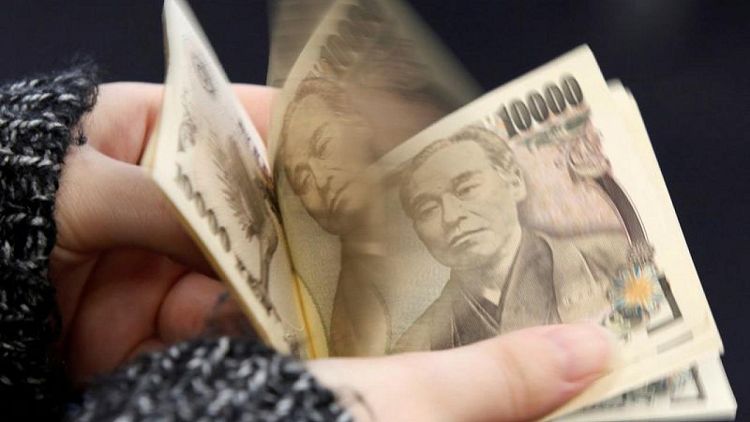By Karen Brettell
NEW YORK - The dollar hit a 20-year high against rivals on Thursday as the Bank of Japan doubled-down on its dovish policy, sending the yen to its weakest level since 2002, while the euro hit a five-year low on growth concerns for the region.
The dollar shot past the key level of 130 yen after the BOJ strengthened its commitment to keep interest rates ultra-low by vowing to buy unlimited amounts of bonds daily to defend its yield target.
"The BoJ gave the 'all clear' to continue selling the yen," said Lee Hardman, a currency analyst at MUFG Bank in London.
There had been some market speculation the BOJ might step back a little given the pressure building across foreign exchange markets.
A finance ministry official responded that Japan will take appropriate action in currency markets, calling recent moves "extremely worrying."
The yen was last at 131.24, the weakest since April 2002, with the greenback up more than 2% against the Japanese currency on the day.
The weak yen helped to catapult the dollar to its highest level since Dec. 2002 against a basket of currencies. The greenback has benefited from expectations the Federal Reserve will hike rates faster than peers, and likely expand the yield gap between U.S. and Japanese government bonds (JGBs).
“This move in dollar/yen has been primarily due to long-end spread widening between U.S. Treasuries and JGBs,” said Bipan Rai, North American head of FX strategy at CIBC Capital Markets in Toronto.
The dollar index was last at 103.73, up 0.74% on the day, after reaching as high as 103.93.
The greenback pared gains after data showed U.S. economic growth unexpectedly contracted in the first quarter as a resurgence in COVID-19 cases disrupted activity.
Rai said, however, that the data did not necessarily reflect a weak economy, but was unduly impacted by a sharply wider trade deficit, which was due to surging imports.
“If you actually peel that away and look at the underlying consumption and investment trends, both of those still look reasonably healthy,” Rai said.
Meanwhile the euro dropped below the psychological level of $1.05 as investors remained nervous about Russia cutting off gas supplies to parts of the region for refusing to pay in roubles.
Russia's Gazprom said on Thursday that Poland is still buying Russian gas in Germany, and that reverse supplies to Poland via the Yamal pipeline amount to around 30 million cubic metres per day.
Meanwhile euro zone government bond yields jumped on strong inflation data, which once fuelled expectations for a quicker pace of monetary tightening by the European Central Bank and could provide some support to the single currency.
The euro was last $1.0501, after earlier getting as low as $1.0470, the lowest since Jan. 2017.
GRAPHIC: Yen and euro reeling against U.S. dollar https://fingfx.thomsonreuters.com/gfx/mkt/klvyklqaqvg/euro2804.PNG
========================================================
Currency bid prices at 10:16AM (1416 GMT)
Description RIC Last U.S. Close Pct Change YTD Pct High Bid Low Bid
Previous Change
Session
Dollar index 103.7300 102.9900 +0.74% 8.433% +103.9300 +102.9900
Euro/Dollar $1.0501 $1.0560 -0.56% -7.64% +$1.0565 +$1.0470
Dollar/Yen 131.1250 128.4300 +2.10% +14.01% +131.1250 +128.3650
Euro/Yen 137.72 135.59 +1.57% +5.66% +137.9800 +135.4400
Dollar/Swiss 0.9735 0.9693 +0.42% +6.70% +0.9759 +0.9681
Sterling/Dollar $1.2422 $1.2547 -1.00% -8.15% +$1.2569 +$1.2416
Dollar/Canadian 1.2859 1.2819 +0.30% +1.69% +1.2880 +1.2798
Aussie/Dollar $0.7066 $0.7127 -0.83% -2.78% +$0.7162 +$0.7067
Euro/Swiss 1.0223 1.0229 -0.06% -1.43% +1.0241 +1.0190
Euro/Sterling 0.8453 0.8417 +0.43% +0.62% +0.8460 +0.8383
NZ $0.6463 $0.6542 -1.15% -5.53% +$0.6543 +$0.6455
Dollar/Dollar
Dollar/Norway 9.4110 9.3290 +0.84% +6.79% +9.4535 +9.2835
Euro/Norway 9.8837 9.8503 +0.34% -1.29% +9.9219 +9.7903
Dollar/Sweden 9.8399 9.8420 -0.52% +9.12% +9.9052 +9.7078
Euro/Sweden 10.3340 10.3876 -0.52% +0.98% +10.3971 +10.2541



